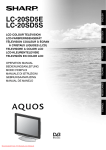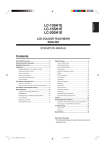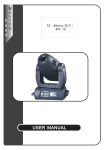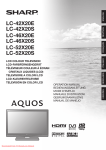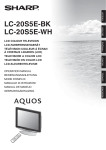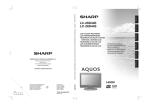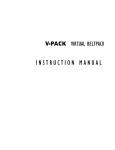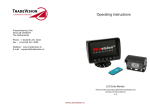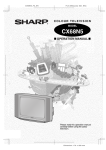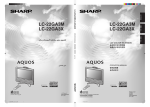Download Sharp LC-20S4E user manual Tv User Guide Manual Operating
Transcript
DEUTSCH ENGLISH LCD COLOUR TELEVISION LCD-FARBFERNSEHGERÄT TÉLÉVISION COULEUR À ÉCRAN À CRISTAUX LIQUIDES (LCD) ITALIANO FRANÇAIS LC-20S4E NEDERLANDS TELEVISIÓN EN COLOR LCD LCD-KLEURENTELEVISIE ESPAÑOL TELEVISORE A COLORI LCD OPERATION MANUAL BEDIENUNGSANLEITUNG MODE D’EMPLOI MANUALE DI ISTRUZIONI MANUAL DE MANEJO GEBRUIKSAANWIJZING Downloaded From TV-Manual.com Manuals SPECIAL NOTE FOR USERS IN THE UK The mains lead of this product is fitted with a non-rewireable (moulded) plug incorporating a 3A fuse. Should the fuse need to be replaced, a BSI or ASTA approved BS 1362 fuse marked or ASA and of the same rating as above, which is also indicated on the pin face of the plug, must be used. Always refit the fuse cover after replacing the fuse. Never use the plug without the fuse cover fitted. In the unlikely event of the socket outlet in your home not being compatible with the plug supplied, cut off the mains plug and fit an appropriate type. DANGER: The fuse from the cut-off plug should be removed and the cut-off plug destroyed immediately and disposed of in a safe manner. Under no circumstances should the cut-off plug be inserted elsewhere into a 13A socket outlet, as a serious electric shock may occur. To fit an appropriate plug to the mains lead, follow the instructions below: IMPORTANT: The wires in the mains lead are coloured in accordance with the following code: Blue : Neutral Brown : Live As the colours of the wires in the mains lead of this product may not correspond with the coloured markings identifying the terminals in your plug, proceed as follows; • The wire which is coloured blue must be connected to the plug terminal which is marked N or coloured black. • The wire which is coloured brown must be connected to the plug terminal which is marked L or coloured red. Ensure that neither the brown nor the blue wire is connected to the earth terminal in your three-pin plug. Before replacing the plug cover make sure that: • If the new fitted plug contains a fuse, its value is the same as that removed from the cut-off plug. • The cord grip is clamped over the sheath of the mains lead, and not simply over the lead wires. IF YOU HAVE ANY DOUBT, CONSULT A QUALIFIED ELECTRICIAN. Downloaded From TV-Manual.com Manuals ENGLISH LC-20S4E LCD COLOUR TELEVISION ENGLISH OPERATION MANUAL Contents Supplied Accessories ............................................... 1 Useful Features ......................................................... 9 Dear SHARP Customer ............................................. 2 Picture Adjustments ............................................. 9 Important Safety Precautions .................................. 2 Sound Adjustments .............................................. 9 Preparation ................................................................ 3 Sound Mode Settings ........................................... 9 Setting the TV ....................................................... 3 NICAM and A2 Stereo Broadcast Selection ......... 9 How to Fix the Cables .......................................... 3 Setup Settings .................................................... 10 How to Prevent the LCD TV Set from Falling Over ... 3 Programmes ....................................................... 11 Installing Batteries in the Remote Control ............ 4 Using the Programme Table ............................... 12 Using the Remote Control .................................... 4 Feature Settings ................................................. 12 How to Adjust the Angle ....................................... 4 Child Lock .......................................................... 13 Part Names of the Remote Control .......................... 5 Teletext ..................................................................... 14 Part Names of the Main Unit ..................................... 6 Troubleshooting ...................................................... 14 Connecting External Devices ................................... 7 LCD TV set ......................................................... 14 Basic Operation ......................................................... 8 Antenna .............................................................. 15 First Installation ..................................................... 8 Specifications .......................................................... 15 Selecting Menu Items ........................................... 8 End of Life Disposal ................................................ 16 Dimensional Drawings • The dimensional drawings for this model are shown on the inside of the back cover. Supplied Accessories Make sure the following accessories are provided with the LCD TV set. Wireless remote control “AAA” size batteries (×2) AC cord * Product shape may vary from country to country. pages 4 and 5 Downloaded From TV-Manual.com Manuals page 4 page 3 Cable clamps (×2) page 3 Operation manual 1 Dear SHARP Customer Thank you for your purchase of the SHARP LCD colour TV product. To ensure safety and many years of troublefree operation of your product, please read the Important Safety Precautions carefully before using this product. Important Safety Precautions • Cleaning—Unplug the AC cord from the AC outlet before cleaning the product. Use a damp cloth to clean the product. Do not use liquid cleaners or aerosol cleaners. • Water and moisture—Do not use the product near water, such as bathtub, washbasin, kitchen sink, laundry tub, swimming pool and in a wet basement. • Stand—Do not place the product on an unstable cart, stand, tripod or table. Doing so can cause the product to fall, resulting in serious personal injuries as well as damage to the product. Use only a cart, stand, tripod, bracket or table recommended by the manufacturer or sold with the product. When mounting the product on a wall, be sure to follow the manufacturer’s instructions. Use only the mounting hardware recommended by the manufacturer. • When relocating the product placed on a cart, it must be moved with utmost care. Sudden stops, excessive force and uneven floor surface can cause the product to fall from the cart. • Ventilation—The vents and other openings in the cabinet are designed for ventilation. Do not cover or block these vents and openings since insufficient ventilation can cause overheating and/or shorten the life of the product. Do not place the product on a bed, sofa, rug or other similar surface, since they can block ventilation openings. This product is not designed for built-in installation; do not place the product in an enclosed place such as a bookcase or rack, unless proper ventilation is provided or the manufacturer’s instructions are followed. Downloaded From TV-Manual.com Manuals 2 • The LCD panel used in this product is made of glass. Therefore, it can break when the product is dropped or applied with impact. Be careful not to be injured by broken glass pieces in case the LCD panel breaks. • Heat sources—Keep the product away from heat sources such as radiators, heaters, stoves and other heat-generating products (including amplifiers). • Do not place vases or any other water-filled containers on this product. The water may spill onto the product causing fire or electric shock. • To prevent fire, never place any type of candle or naked flames on the top or near the TV set. • To prevent fire or shock hazard, do not place the AC power cord under the TV set or other heavy items. The LCD panel is a very high technology product with 921,600 thin film transistors, giving you fine picture details. Due to the very large number of pixels, a few non-active pixels may occasionally appear on the screen as a fixed point of blue, green or red. This is within product specifications and does not constitute a fault. Do not display a still picture for a long time, as this could cause an afterimage to remain. There is power consumption always if main plug is connected. Preparation Setting the TV Rear view Carrying handle Removing the terminal cover Round lock for Kensington Security Standard slot* * Using the Kensington Lock • This LCD TV set has a Kensington Security Standard slot for use with a Kensington MicroSaver Security System. Refer to the information that came with the system for instructions on how to use it to secure the LCD TV set. Pull down the hook to open the cover. AC INPUT terminal (220-240 V) 75-ohm coaxial cable (round cable) To antenna terminal ( AC cord Product shape may vary from country to country. ) Antenna terminal ( ) NOTE • Unplug the AC cord from the LCD TV set and power outlet when the LCD TV set is not to be used for a long period of time. • Please ensure your 75-ohm coaxial cable is fitted with a DIN 45325 (IEC169-2) coaxial plug and plug it into the antenna terminal at the side of the LCD TV set (antenna cable not supplied). How to Fix the Cables Secure cables and cords with the supplied cable clamps so that they do not get caught when mounting the cover. How to Prevent the LCD TV Set from Falling Over To prevent the LCD TV set from falling over in case of earthquakes and so on, strap it onto the wall by threading one end of the string through the loop of the stand (1) and fastening the LCD TV set with the string attached to the hook on the wall or the post, etc. (2). (An example of strapping the LCD TV set onto the wall is shown below.) • The string and hook are commercially available. 2 Cable clamps Downloaded From TV-Manual.com Manuals 1 3 Preparation (continued) Installing Batteries in the Remote Control Before using the LCD TV set for the first time, install the two “AAA” size batteries (supplied) in the remote control. When the batteries become depleted and the remote control fails to operate, replace the batteries with new “AAA” size batteries. 1 2 Open the battery cover. • Slide the cover while pressing the ( ) part. Insert two “AAA” size batteries. 3 • Place batteries with their terminals corresponding to the (+) and (–) indications in the battery compartment. Caution! Close the battery cover. • Engaging the lower claw with the remote control, close the cover. Precautions regarding batteries Improper use of batteries can result in a leakage of chemicals and/or explosion. Be sure to follow the instructions below. • Different types of batteries have different characteristics. Do not mix batteries of different types. • Do not mix old and new batteries. Mixing old and new batteries can shorten the life of new batteries and/or cause old batteries to leak chemicals. • Remove batteries as soon as they are depleted. Chemicals that leak from batteries can cause a rash. If chemical leakage is found, wipe it off with a cloth. • The batteries supplied with the LCD TV set may have a shorter operating time due to storage conditions. • If the remote control is not to be used for an extended period of time, remove the batteries from the remote control. Using the Remote Control Use the remote control by pointing it towards the remote sensor window of the main unit. Objects between the remote control and sensor window may prevent proper operation. 30˚ Cautions regarding use of the remote control • Do not apply shock to the remote control. In addition, do not expose the remote control to liquids, and do not place it in an area with high humidity. • Do not install or place the remote control in direct sunlight. The heat may cause deformation to it. • The remote control may not work properly if the remote sensor window is in direct sunlight or strong light. In such a case, change the angle of the lighting or main unit, or operate the remote control closer to the remote sensor window. How to Adjust the Angle To change the vertical angle of the LCD TV set, tilt the screen up to 2.5 degrees forwards or 10 degrees backwards. The LCD TV set can also be rotated up to 25 degrees to right and left. Please adjust the angle so that the LCD TV set can be watched most comfortably. Tilt the display by grabbing onto the carrying handle while securely holding down the stand with other hand. Downloaded From TV-Manual.com Manuals 4 7m 30˚ Remote sensor Part Names of the Remote Control (Subpage) (P. 14) Displays the Teletext Subpage directly. BACKLIGHT (P. 12) Selects the brightness and OPC of the display. (Hold) (P. 14) Temporarily holds the current Teletext page. (Teletext) (P. 14) Displays the Teletext mode screen. (Power) Switches the LCD TV set power on or standby. (Reveal) (P. 14) Displays hidden information such as solutions to riddles and puzzles. (Subtitle) (P. 14) Displays the Teletext Subtitle directly. ROTATE (P. 10) Rotates the display in every direction. OK, Programme Table (P. 8, 12) (Sound) (P. 9) Switches to the sound mode. END (P. 8) Returns to normal screen. Right / Left Selection (P. 8) Upwards / Downwards Selection, Zoom Display Function (Teletext mode) (P. 8, 14) Red, Picture menu (P. 9, 14) Green, Sound menu (P. 9, 14) (+)/(-) (Volume) Changes the sound volume. MENU (P. 8) Displays the TV menu. Returns to the previous screen. TV Volume 10 Blue, Status Display (P. 12, 14) Turns on the status display when the menu is not displayed. Channel Select TV input mode: Selects the channel. This LCD TV set allows you to select up to 200 channels (0 to 199). Teletext mode: Selects the page. (P. 14) Yellow, Sleep Timer (P. 12, 14) (Flashback) Switches the channels between the currently tuned one and the previous one. (Mute) Switches the sound on and off. Sound off (Input) Switches the input source between EXT1, EXT2 and TV modes. Mode: EXT1 EXT1 EXT2 EXT2 TV 1 S- 6 NOTE • EXT1: Select this mode when viewing the signals from the video equipment connected to the EXT1 (21-pin Euro-SCART (RGB)) terminal. • EXT2: Select this mode when viewing the signals from the video equipment connected to the EXT2 terminals using the VIDEO or S-VIDEO terminal for video input. If both VIDEO and S-VIDEO terminals are connected with cables, the S-VIDEO input terminal is selected as the high priority. Downloaded From TV-Manual.com Manuals Sound on • When (+)/(-) is pressed in the Mute mode, the sound turns on, and the volume indicator is displayed. • The Mute function is cancelled when is pressed. P ( )/( ) (Channel) TV input mode: Selects the channel. • Channel “0” is reserved for RF output of VCR. • Channels not set with “Automatic search” or via “Setup” are set to be skipped and therefore cannot be displayed using P ( )/( ). Teletext mode: Selects the page. (P. 14) 5 Part Names of the Main Unit Controls Upper control panel ■ Using the control panel of the main unit • (Input), P ( )/( ) (Channel), i (–)/(+) (Volume) and MENU on the control panel of the main unit have the same functions as the same buttons on the remote control. Fundamentally, this operation manual provides a description based on operation using the remote control. (MAIN POWER) • The STANDBY/ON indicator instantly changes from red to green and the LCD TV set is turned on. again. • To turn off the main power, press ■ Operating the menu with the control panel (See page 8.) Button operations on the control panel correspond to the ones on the remote control as shown below. (Input) MENU P ( )/( OK on the remote control MENU on the remote control ) (Channel) i (–)/(+) (Volume) "/' on the remote control \/| on the remote control Headphones Plug the headphone mini-plug into the headphone jack. Adjust the sound volume using i (+)/(–) on the remote control. Speaker On-screen display TV Volume 10 NOTE • Headphones are not included in the supplied accessories. • No sound is heard from the main unit speakers when a headphone mini-plug is connected into the headphone jack. • Do not set the volume at a high level. Hearing experts advise against extended listening at high volume levels. OPC sensor OPC (Optical Picture Control) indicator The OPC indicator lights up green when the “Backlight” is set to “Auto (OPC)”. (See page 12.) Remote sensor STANDBY/ON indicator The STANDBY/ON indicator lights up green when the power is on, and red when in the standby mode (the indicator will not light when the main power is off). Downloaded From TV-Manual.com Manuals 6 Connecting External Devices You can enjoy picture and sound by connecting devices, such as a VCR or home video game system, to the terminals located on the rear of the LCD TV set. When connecting an external device, turn off the power of the LCD TV set first to prevent any possible damage. Terminals Antenna terminal To EXT1 terminal <Example> EXT1 RGB (21-pin Euro-SCART) Decoder VCR DVD Player 21-pin Euro-SCART connector To EXT2 terminal EXT2 <Example> S-VIDEO S-Video S-Video cable DVD Player VCR Camcorder Home video game system VIDEO AUDIO (L) AUDIO (R) Video Audio (L) Audio (R) Audio/Video cable To AUDIO OUT terminal AUDIO OUT <Example> AUDIO OUT (L) AUDIO OUT (R) Audio amplifier Audio (L) Audio (R) Audio cable NOTE • • • • • For the cable, use a commercially available audio/video cable. PC connection is not possible. For more information about external device connections, see the operation manuals of your external devices. Make sure that the corresponding cables are connected to each terminal. Connecting other cables may result in a malfunction. EXT2 has two terminals, VIDEO and S-VIDEO terminals. If your external device has an S-VIDEO terminal, S-VIDEO connection is recommended. S-VIDEO provides a finer, more detailed picture. If both terminals are connected, S-VIDEO terminal takes a priority. Downloaded From TV-Manual.com Manuals 7 Basic Operation First Installation Selecting Menu Items When you turn on the LCD TV set for the first time, the First Installation routine, which makes installation easier, is activated. Using this routine, you can select the on-screen display language, clock setup and automatically search for and store all the receivable TV channels. NOTE • You can also execute the First Installation routine by selecting “First installation” on the Setup Menu screen. For selecting the menu items, see the right column. The menus can be used to adjust the various settings of your LCD TV set. For details on setting each menu item, refer to the page number indicated below. NOTE • The illustrations and on-screen displays in this manual are for explanation purposes and may vary slightly from the actual appearance. • “Programmes” or “First installation” cannot be set when the EXT1 or EXT2 mode is selected as an input mode. • Settings most recently adjusted will be saved in memory. ■ Using the remote control 1 1 2 Press 2 Press '/"/\/| to select the desired language, and press OK. English Russian Español Português Deutsch Türkçe Français Greek Italiano Suomi Svenska Polski Nederlands 3 Press '/" to set the time, and press OK. • The time you set is automatically updated via Teletext time information. 0 0 : 0 0 : 0 0 4 Press '/" to select the desired item, and press \/| to make the setting. Country Colour system Sound system Start UK PAL I search NOTE • You can change “Colour system” and “Sound system” only when “Other count.” is selected in “Country”. 5 Press '/" to select “Start search”, and press OK. • The automatic programme search begins. 6 Press END to exit NOTE • After the First installation routine, you can change the settings of “Language” (page 10) and “Clock setup” (page 10), and perform “Automatic search” (page 11) again. Press \/| to select the desired menu item. • The cursor moves left or right. • The cursor indicates the selected menu item. (MAIN POWER) on the LCD TV set. • The “First installation” screen with a list of the languages for the on-screen display is displayed. Press MENU to display the Menu screen. 3 Press '/" to select the desired item, and press \/| to adjust the selected item. 4 Press MENU to return to the previous screen or END to return to the normal screen. P C B C T S R i o r o i h e c n i l n a s t t g o t r e S S T B B L A S R o o r a a o V o e u u e s l u S P F R E C L T e r i o X l a e t o r t T o n l B S A O C a l u n h Fea ckli eep to p scr ild n n b s a d a un se u g s a u r h u re ast tness r pness t nce sp. sound udio sig. d wide t p r t t c ck gu et 5 ] ] ] ] ] Page - + + + - + ' ' ' ' ' ' Page d d via le [TV] [ ][ ][ ]L ' ' ' ' ' ' ' ' + + R Page am i e on s ag ex t g t o e l & mes nstallation nections etup e t language u h i w e o r t m e n c es Page ! er r off disp. k The bar below is an operational guide for the remote control. The bar will change in accordance with each menu setting screen. :Select Downloaded From TV-Manual.com Manuals 8 [ [ [ [ [ O K :Enter MENU : B a c k END : E x i t Useful Features :Select O K :Enter MENU : B a c k END : E x i t Sound Mode Settings You can make various sound mode settings. Picture Adjustments Adjust the picture to suit your preference. See the table below for the adjustment items. 1 2 3 4 1 Perform steps 1 and 2 in Sound Adjustments to display the Sound Menu screen. 2 3 4 Press '/" to select the desired item, and press OK. Press '/" to select the sound mode, and press OK. Press END to exit. Selected item Choice Press MENU to display the Menu screen. Sound via • The Picture Menu screen can be displayed directly by pressing the Red button. Loudsp. sound Stereo TV Hi-fi Sound 1 Press \/| to select “Picture”. Nicam Press '/" to select a specific adjustment item. Press \/| to adjust the item to your desired position, and press END to exit. Mono Sound 2 Sound 1+2 Mono Mono Mono AV audio sig. Sound 1 Sound wide* On (For increasing the spread of the sound) Sound 2 Sound 1+2 Off * This item cannot be selected when “Sound via” is set to “Hi-fi”. Selected item \ button | button Contrast For less contrast For more contrast Brightness For less brightness For more brightness Colour For less colour intensity For more colour intensity Tint Skin tones become purplish. Skin tones become greenish. Sharpness For less sharpness For more sharpness Adjust the sound quality and volume to suit your preference. See the table below for the adjustment items. Press MENU to display the Menu screen. • The Sound Menu screen can be displayed directly by pressing the Green button. 2 3 4 Press \/| to select “Sound”. Press '/" to select a specific adjustment item. Press \/| to adjust the item to your desired position, and press END to exit. Selected item \ button Hi-fi Volume 20 For the “Loudsp. sound” setting • The sound output modes differ depending on whether or not a NICAM or A2 stereo signal is received. See “NICAM and A2 Stereo Broadcast Selection” below. Sound Adjustments 1 NOTE For the “Sound via” setting • When setting “Sound via” to “Hi-fi” in the Sound Menu screen, the sound from the built-in speakers will be turned off. To exit this mode, switch “Sound via” from “Hi-fi” to “TV” in the Sound Menu screen. • You can adjust the volume by pressing i (+)/(–). | button Treble* For weaker treble For stronger treble Bass* For weaker bass For stronger bass Balance* Decrease audio from the right speaker. Decrease audio from the left speaker. * These items cannot be adjusted when “Sound via” is set to “Hi-fi”. For the “AV audio sig.” setting • Select “Sound 1” or “Sound 2” when playing back the video from mono-video recorders and “Sound 1+2” when playing back from stereo-video recorders. NICAM and A2 Stereo Broadcast Selection This enables the selection of the reception mode when receiving a NICAM-I, NICAM-B/G or an A2 stereo signal. To let you enjoy NICAM or A2 stereo broadcasting, this LCD TV set receives NICAM stereo system, A2 stereo system, bilingual, and monaural broadcasts. Each time you press follows: Broadcast (Sound), the mode changes as Stereo* Bilingual Stereo Sound 1 Mono Mono Stereo Sound 1 Mono Mono Monaural Sound 2 Nicam Sound 1+2 Mono NICAM NOTE For the picture and sound adjustments • When resetting all adjustment items to factory preset values, perform the following procedure. 1 Press '/" to select “Reset”, and press OK. 2 Press '/" to select “Yes”, and press OK. Sound 2 – A2 Stereo Sound 1+2 * When “Mono” is selected, the TV sound is output monaurally. NOTE • If the button is not pressed for a few seconds, the mode setting is automatically terminated and the LCD TV set returns to the normal mode. Downloaded From TV-Manual.com Manuals 9 Useful Features (continued) Setup Settings 1 2 3 4 5 Press MENU to display the Menu screen. Press \/| to select “Setup”. S P F R E C L T Press '/" to select the desired item, and press OK. Press '/" to select the desired mode, and press OK. Press END to exit. Selected item Programmes First installation Rotate*1 e r i o X l a e t o r t T o n l u g s a p r t t c ck gu et am i e on s ag ex mes nstallation nections etup e t language Choice/Description See page 11. See page 8. Normal Normal image orientation. Mirror To display mirror images for special uses. Rotate To display rotated images for special uses. Upside down To display upside-down images for special uses. Normal Mirror Rotate Upside down EXT connections EXT1 EXT2(Y/C) EXT2(CVBS) Clock setup It is possible to manually adjust various settings for connections with external devices on the “EXT connections” screen. Select the appropriate signal type and colour standard for the signals from the video equipment connected to the EXT1 or EXT2 terminal. EXT1 Signal type*2 Auto, CVBS, RGB: To select the signal type of external equipment. EXT2 (Y/C) AFC Mode 1, Mode 2: To select frequency control modes. EXT2 (CVBS) Mode 1 is suitable for DVD players or decoders, and Mode 2 is suitable for VCRs or camcorders. Colour Auto, PAL, SECAM, N358 (NTSC 3.58), N443 (NTSC 4.43), PAL-M, system*3 PAL-N, PAL60 Press '/" to set the time, and press OK. 1 2 : 0 0 : 0 0 Language Teletext language West europe East europe The language for the on-screen display can be selected from English, Spanish, German, French, Italian, Swedish, Dutch, Russian, Portuguese, Turkish, Greek, Finnish, and Polish. The language for the Teletext can be selected from West europe, East europe, Turkish/Greek, and Cyrillic. Turkish/Greek Cyrillic *1 Direct setting can be made with ROTATE of the remote control. *2 This item is visible only when “EXT1” is selected for the “EXT connections” setting. *3 This item works only when “CVBS” is selected for the “Signal type”. NOTE EXT connections: • If no (colour) image is displayed, try to change to a different signal type. • Depending on the compatibility with the various types of equipment, the picture may become skewed. In this case, select the “AFC” (Automatic Frequency Control) mode that will improve the picture. • Switching between AV input signals may be slow, depending on the settings in “Colour system”. If you want to speed up signal switching, select “Auto” in “Colour system” to the current reception colour system. Clock setup: • The time is automatically set or corrected via the Teletext broadcast when available. Downloaded From TV-Manual.com Manuals 10 Useful Features (continued) :Select O K :Enter MENU : B a c k END : E x i t Programmes 1 2 3 4 5 Press MENU to display the Menu screen. Press \/| to select “Setup”. Press '/" to select “Programmes”, and press OK. Press '/" to select the desired item, and press OK. Press END to exit. A M S E E u a o r n t n r a t o u t s e matic search al adjustment e r programme range / Change name [1] Automatic Search Perform the procedure above to search for and store new TV programmes after the First Installation routine. C C S S S o o o t t u l u o a n o n r r try ur sy d sys e pro t sea s t g r tem em . from ch UK PAL I Selected item Country Colour system Sound system Store prog. from Choice/Description Select your country or area from the displayed items. Auto, PAL, SECAM B/G, I, D/K, L/L’, Auto Press '/"/\/| to select the programme position from which the programmes are to be stored, and press OK to return to the automatic search setting screen. Start search Start Automatic search. NOTE • You can change “Colour system” and “Sound system” only when “Other count.” is selected in “Country”. • See page 8 for details on the search process. [2] Manual Adjustment Individual settings of programmes can be adjusted. C F N C S S h r a o o k a e m l u i n q e o n p nel uency ur system d system 1 2 E P I O 99 24.25MHz 12 AL ff Selected item Choice/Value range Description Channel 0–199 The channel changes to the higher or lower channel. Frequency 044 – 859 (MHz) Receivable frequencies depending on TV norm, installation site, and range. Name Alphabets, numerical Programme name (up to 5 characters) values and symbols (e.g. !, t, etc.) Colour system Auto, PAL, SECAM Colour norm Sound system B/G, I, D/K, L/L’, Auto TV norm Skip On Off Channel numbers with a “(♦) (RED)” mark on the left are set to Skip. NOTE • Depending on the settings in the colour system of the channels, switching between channels may be slow. If you want to speed up channel switching, switch “Auto” in “Colour system” to the current reception system (PAL or SECAM). [3] Sort The programme positions for individual programmes can be changed freely. Press '/"/\/| to select the desired programme, and press OK to sort. • When OK is pressed, the Move mode is activated. Press '/" to move the currently marked programme to the desired programme position. When the channel has moved to the desired position, all the preceding/subsequent channel position will go up/down. Press OK to exit the Move mode. [4] Erase Programme Range The individual programme or programmes in a connected range can be erased. Press '/"/\/| to select the programme to be erased, and press OK. • If you want to erase programmes in a connected range, select the first programme of the range, and then select the last one. Press OK to erase the selected programme(s). All the subsequent programmes move up. [5] Enter/Change Name The name of an individual programme can be entered or changed. Press '/"/\/| to select the desired programme, and press OK. Press \/| to select the input position, and press '/" to select the desired character. Press OK to accept the name entered, and press END to exit. Downloaded From TV-Manual.com Manuals 11 Useful Features (continued) Using the Programme Table The Programme table shows a list of all receivable programmes. They are located in channels 0 to 199. To select the desired programme 1 2 Press OK to display the Programme table. Press '/"/\/| to select the desired programme. • To display the next or previous list of the Programme table, press '/" when the cursor is at a programme in the lower-right or upper-left position, or press \/| when the cursor is at a programme in the right or left column. 3 0 1 2 3 4 5 6 7 S S S S E E E - 6 8 1 0 11 3 5 6 1 1 1 1 1 1 8 9 0 1 2 3 4 5 E E E E E E E E - r t m e n c es 1 1 3 3 3 5 5 9 0 1 6 7 8 0 3 1 1 1 1 2 2 2 2 6 7 8 9 0 1 2 3 EEE- 54 56 57 Press OK to display the selected programme, and press END to exit. Feature Settings 1 2 3 4 5 Press MENU to display the Menu screen. B S A O C Press \/| to select “Features”. Press '/" to select the desired item, and press OK. a l u n h Fea ckli eep to p scr ild t g t o e l u h i w e o er r off disp. k Press '/" to select the desired mode, and press OK. Press END to exit. Selected item Backlight*1 Auto (OPC) Choice Description Auto (OPC) Screen brightness is adjusted according to the ambient light of the room. Bright Maximum brightness. Medium Suitable for viewing in well-lit areas. Saves energy. Dark Sufficiently bright when viewing in dim areas. Off You can set “Sleep timer” to automatically turn off the LCD TV set. Bright Medium Dark Sleep timer*2 30Min Off 3 0 Min 60Min 6 0 Min 90Min 9 0 Min 12 0 Min 120Min Auto power off On You can set the power to automatically turn off if there is no signal for 5 minutes. Off On screen disp.*3 P S T S o o i l s u m e ition nd info. e ep time You can adjust various settings for on-screen displays. B Y N N ottom es o o Position Bottom Sound info. No Yes Top To select whether or not sound info is to be displayed, when a channel has been selected. To select the position of the on-screen display. Time No Yes To select information to be displayed on the on-screen display. Sleep time Child lock See page 13. 1 * Direct setting can be made with BACKLIGHT of the remote control. *2 The status display appears by pressing the Yellow button. *3 The status display appears by pressing the Blue button. NOTE Backlight: • When set to “Auto (OPC)”, make sure that no object obstructs the OPC sensor, which could affect its ability to sense surrounding light. Downloaded From TV-Manual.com Manuals 12 Useful Features (continued) To set a Child Lock for individual programmes Child Lock 1 Perform steps 1 and 2 in [2] Setting a Child Lock to display the “Child lock” screen. 2 Press '/" to select “For individual prog. only”, and press OK. Important: • Please refer to page 16 for “IMPORTANT NOTE ON DISENGAGING ADVANCED CHILD LOCK”. The Child lock function blocks the viewing of any channels. To use this function, you need to define your PIN (Personal Identification Number) first. F F C C [1] Defining a PIN 1 2 3 Press MENU to display the Menu screen. 4 Input the desired four-digit PIN (e.g. 1234) with Channel Select, and press OK. Press \/| to select “Features”. 3 4 define 1 2 3 your PIN r a r i ang nce ll programmes ndividual prog. e PIN l PIN only Press '/"/\/| to select the desired programme. Press OK to lock the programme. • The locked programme is displayed in red. Press '/" to select “Child lock”, and press OK to display the PIN input screen. Please o o h a NOTE • To unlock the programme, select the programme, and press OK. • The Child lock remains effective until it is cancelled. 5 Press END to exit. 4 [3] Changing/Cancelling a PIN NOTE • Be sure to make a note of your PIN before pressing OK. • The PIN will not be set if MENU or END is pressed before the fourth digit has been input. 5 Press OK to accept the input PIN. To change a PIN 1 2 Perform steps 1 and 2 in [2] Setting a Child Lock to display the “Child lock” screen. Press '/" to select “Change PIN”, and press OK. • The currently defined PIN is displayed. [2] Setting a Child Lock • There are two different ways of activating a Child lock: 1. General child lock for all programmes 2. Programme-position-related child lock To set a Child Lock for all programmes 1 Perform steps 1 to 3 in [1] Defining a PIN to display the PIN input screen. 2 Input your four-digit PIN (e.g. 1234) with Channel Select. Please input ? ? ? your PIN ? • When the PIN is correctly input, the “Child lock” screen is displayed. 3 Press '/" to select “For all programmes”, and press OK. F F C C o o h a r a r i ang nce ll programmes ndividual prog. e PIN l PIN F F C C o o h a r a r i ang nce ll programmes ndividual prog. e PIN l PIN only 3 Input the new four-digit PIN (e.g. 5678) with Channel Select, and press OK. 4 Press END to exit. To cancel a PIN 1 In step 2 above, press '/" to select “Cancel PIN”, and press OK. 2 Press '/" to select “Yes”, and press OK. [4] Temporarily cancelling the Child Lock setting You can view a programme for which a Child lock has been set by temporarily cancelling the Child lock setting. Perform the procedure below to input your PIN and cancel the Child lock if you are prompted to do so. only When the PIN input screen is displayed, input your PIN with Channel Select. 4 Press '/" to select “Yes”, and press OK. • The lock remains effective until “No” is selected. • The normal screen appears when the PIN is correctly input. 5 Press END to exit. Please input ? Downloaded From TV-Manual.com Manuals ? ? your PIN ? 13 Teletext ■ What is Teletext? Teletext is an information service organised like a magazine, which is provided by some TV stations in addition to regular television broadcasting. Your LCD TV set receives special Teletext signals broadcast by a TV station, processes the information and displays it graphically on the screen. News, weather and sports information, stock exchange prices, programme reviews and closed captioning for people hard of hearing are among the many services available through Teletext. 100 TELETEXT Red ■ Teletext mode Teletext is turned on/off with (Teletext) on the remote control. You can operate your LCD TV set in Teletext mode directly by inputting commands with the remote control. ■ Operating instructions in Teletext mode • The FLOF system for Teletext is transmitted in the UK currently. • The TOP system for Teletext is transmitted in Germany currently. Operation button* P ( )/( ) Channel Select (0-9) (Teletext) (Subpage) Channel Select (0-9) (Hold) '/" Green Yellow Blue ■ Using the TOP line When TOP Teletext is being broadcast, a control line and TOP line can be displayed on the screen. The TOP line involves the operating instructions associated with all of the Coloured buttons if TOP text is transmitted. Press the Coloured buttons to operate the Teletext screen. • Press Red to display the previous page and Green to display the next page. Yellow and Blue are as indicated on the TOP line. Description To turn off the function Changes the page number. Directly select any page from 100 to 899 by using 0-9. – Displays Teletext screen. Press again. Displays a control line to change subpages. Select the desired subpage number by using 0-9. Press again. Holds the current Teletext page. Press again. Zooms the current Teletext page as shown below. ABC DEF ABC – DEF (Subtitle) Quickly activates subtitles. Press (Reveal) Display hidden information. Press . again. * See page 5 for details on the operation buttons. NOTE • For selecting the language for the Teletext screen, see “Teletext Language” on page 10. Troubleshooting Before calling for repair services, make the following checks for possible remedies to the symptoms encountered. LCD TV set Problem Check item • Reception other than that of broadcasting stations could be the problem. • Make sure the input mode is set to TV. There is no • Make sure the main power switch of picture or sound. the LCD TV set is on. • Make sure the Picture adjustment is There is no properly adjusted. picture from • The fluorescent lamp may have EXT2 . reached the end of its service life. • Make sure the S-VIDEO terminal has nothing connected. • Make sure the volume is not set to minimum. • Make sure the sound is not set to mute. • Make sure the antenna cable is There is no picture or sound, properly connected. • Bad reception could be the problem. just noise. The picture is not clear. Downloaded From TV-Manual.com Manuals 14 Page – 5 6 9 Problem 9 The picture is too dark. • Check if “Backlight” is set to “Dark”. • Check “Contrast”. • The fluorescent lamp may have reached the end of its service life. 12 9 – • Check if batteries in the remote control have sufficient power. • Make sure the remote sensor window is not in strong light. 4 Remote control does not work. • External influences such as lightning, static electricity, etc., may cause improper operation. In this case, operate the unit after turning the power off, or unplugging the AC cord and re-plugging it in 1 or 2 minutes. – 5 5 3 – Page • Check the colour adjustment. The picture is too light or improperly tinted. – 7 Check item Unit cannot be operated. 4 Troubleshooting (continued) Antenna Problem Check item The picture is not sharp. The picture shakes. • • • • The picture has ghosts. • Make sure the antenna is facing the correct direction. • Broadcast waves may be reflected from adjacent mountains or buildings. The picture is spotted. • There may be interference from automobiles, trains, high-voltage lines, neon lights, etc. • There may be interference between the antenna cable and power cable. Try positioning them further apart. There are stripes on the screen or colours fade. • Is the unit receiving interference from other devices? Transmission antennas of radio broadcasting stations and transmission antennas of amateur radios and mobile phones may also cause interference. • Use the unit as far apart as possible from devices that may cause possible interference. The reception may be weak. The quality of the broadcast may also be bad. Make sure the antenna is facing the correct direction. Make sure the outside antenna has not been disconnected. ■ Cautions regarding use in high and low temperature environments • When the unit is used in a low temperature space (e.g. room, office), the picture may leave trails or appear slightly delayed. This is not a malfunction, and the unit will recover when the temperature returns to normal. • Do not leave the unit in a hot or cold location. Also, do not leave the unit in a location exposed to direct sunlight or near a heater, as this may cause the cabinet to deform and the LCD panel to malfunction. (Storage temperature: –20°C to +60°C (–4°F to +140°F) Specifications Model LCD panel Number of dots Video colour system TV Brightness Lamp life Viewing angles Audio amplifier LC-20S4E Speakers 20" Advanced Super View & BLACK TFT LCD Terminals 921,600 dots VGA PAL/SECAM/NTSC TV-Standard (CCIR): B/G, I, D/K, L/L’ TV-Tuning System: Auto preset 200 ch. STEREO/BILINGUAL: NICAM, A2 stereo OSD language AUTO PRESET: YES CATV: ~Hyper Band 430 cd/m2 Power requirement 60,000 hours* Power consumption H: 170˚ V: 170˚ Weight (approx.) 2.1 W × 2 Operating temperature 11 cm × 4 cm 2 pcs. EXT1: 21-pin Euro-SCART EXT2: S-VIDEO, VIDEO, AUDIO OUT: AUDIO Antenna: DIN Headphones: 3.5 mm ø jack (front) English/Spanish/German/French/ Italian/Swedish/Dutch/Russian/ Portuguese/Turkish/Greek/Finnish/Polish AC 220-240 V, 50/60 Hz 68 W (0.8 W Standby) AC 230 V Display only: 6.3 kg Display with stand: 7.0 kg 0°C to +40°C (+32°F to +104°F) * Typical time for power output decrease of about one-half assuming continuous use in a room with normal lighting, normal brightness and temperature at 25˚C/77˚F ■ As a part of policy of continuous improvement, SHARP reserves the right to make design and specification changes for the LCD TV set improvement without prior notice. The performance specification figures indicated are nominal values of production units. There may be some deviations from these values in individual units. The Consumer Electronics Industry has initiated a commitment to improve the energy efficiency of TVs. SHARP has signed this commitment and as a result this TV may have a label on the front of the product informing the customer of the energy consumption in various operating modes. 365 “ON” : The energy consumption (W) of the set when operating with picture and sound (measured according to IEC 62087:2002) “Standby” : The energy consumption (W) of the set when in standby, no picture or sound (measured according to IEC 62087:2002) An estimated annual energy consumption (kWh) based on a duty cycle of 4 hours “on” and 20 hours in “standby” for 365 days Note: The IEC 62087:2002 measurement standard sets brightness and sound levels that may not be the same as the TV in “shipped” condition. Therefore the power consumption as measured at “on” is purely indicative and may not be the same value as in the “shipped” condition. Downloaded From TV-Manual.com Manuals 15 End of Life Disposal A. Information on Disposal for Users (private households) 1. In the European Union Attention: If you want to dispose of this equipment, please do not use the ordinary dust bin! Attention: Your product is marked with this symbol. It means that used electrical and electronic products should not be mixed with general household waste. There is a separate collection system for these products. Used electrical and electronic equipment must be treated separately and in accordance with legislation that requires proper treatment, recovery and recycling of used electrical and electronic equipment. Following the implementation by member states, private households within the EU states may return their used electrical and electronic equipment to designated collection facilities free of charge*. In some countries* your local retailer may also take back your old product free of charge if you purchase a similar new one. *) Please contact your local authority for further details. If your used electrical or electronic equipment has batteries or accumulators, please dispose of these separately beforehand according to local requirements. By disposing of this product correctly you will help ensure that the waste undergoes the necessary treatment, recovery and recycling and thus prevent potential negative effects on the environment and human health which could otherwise arise due to inappropriate waste handling. 2. In other Countries outside the EU If you wish to discard this product, please contact your local authorities and ask for the correct method of disposal. For Switzerland: Used electrical or electronic equipment can be returned free of charge to the dealer, even if you don’t purchase a new product. Further collection facilities are listed on the homepage of www.swico.ch or www.sens.ch. B. Information on Disposal for Business Users 1. In the European Union If the product is used for business purposes and you want to discard it: Please contact your SHARP dealer who will inform you about the take-back of the product. You might be charged for the costs arising from take-back and recycling. Small products (and small amounts) might be taken back by your local collection facilities. For Spain: Please contact the established collection system or your local authority for take-back of your used products. 2. In other Countries outside the EU If you wish to discard of this product, please contact your local authorities and ask for the correct method of disposal. IMPORTANT NOTE ON DISENGAGING ADVANCED CHILD LOCK We suggest that you remove the following instruction from the operation manual to prevent children from reading it. As this operation manual is multilingual, we also suggest the same with each language. Keep it in a safe space for future reference. If you have forgotten your personal code number and cannot disengage ADVANCED CHILD LOCK, follow the procedure below. 1. Press MENU to display the Menu screen. 2. Press \/| to select “Features”. 3. Press '/" to select “Child lock”, and press OK. 4. The PIN input menu is displayed. 5. Input “3001” with Channel Select. The Child lock setting menu is displayed. Downloaded From TV-Manual.com Manuals ADVANCED CHILD LOCK will now be disengaged. 16 Dimensional Drawings Unit: mm 117 310 138.9 53.4 482.8 97.6 43.3 293.4 447 300.8 432.5 475.8 403.1 151 100 48.2 100 224 Downloaded From TV-Manual.com Manuals SHARP CORPORATION Printed on environmentally friendly paper Auf ökologischem Papier gedruckt Imprimé sur papier écologique Stampato su carta ecologica Impreso en papel ecológico Afgedrukt op ecologisch papier ECF Printed in Malaysia Gedruckt in Malaysia Imprimé en Malaisie Stampato in Malesia Impreso en Malasia Gedrukt in Maleisië TINS-B892WJZZ 05P09-MA-NM Downloaded From TV-Manual.com Manuals




















